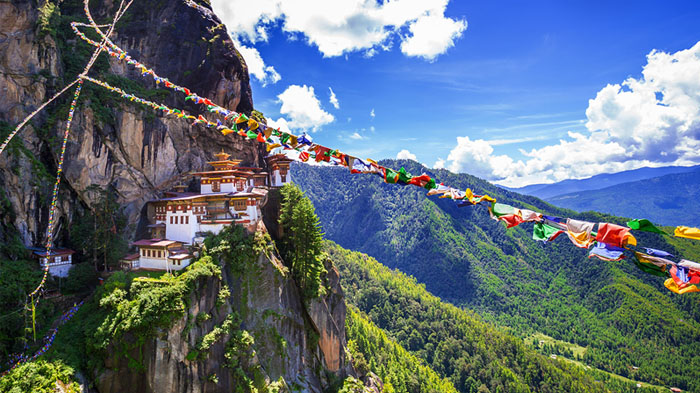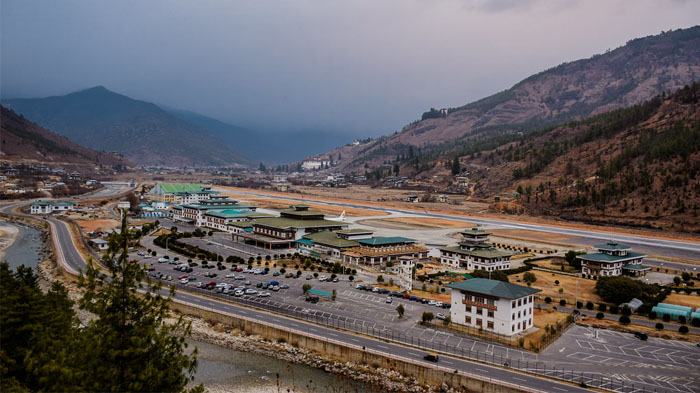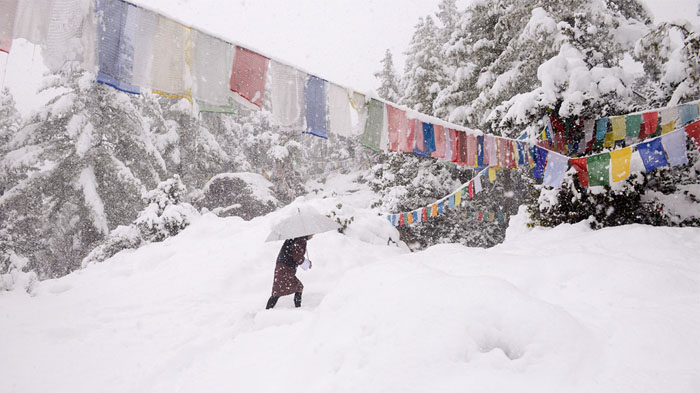
Weather and climate of Paro
The weather in Bhutan is difficult to generalize, as the country has a variety of climates depending on altitude. The general seasons are the same across the whole country, though, with four standard seasons. Spring runs from March to mid-June and is a dry and cool season with little rain, while autumn, from September to November is another cool and dry season, with clear skies and little rain. Summer is the monsoon season, and runs from June to mid-September, with plenty of rain across the country, though less in the northern mountains. Winter is the cold time of year, with low temperatures in the north and occasional snow, and warmer milder winters in the south that are dry and bright.
Paro is one of the warmer areas of Bhutan, compared with the capital which has a colder winter and milder summer. However, it can still get cold in the winter months, and compared to Punakha to the east, is much colder than the favored trekking area. Summers in Paro are warm and humid, with temperatures reaching as high as 21 degrees, and winter lows can get down to -2 degrees in the coldest months.
What is Paro weather and climate by month?
Paro Weather Guide
 Table of Paro Weather Guide
Table of Paro Weather Guide
Spring (March - May)
Average daytime temperature: 18°C
Average nighttime temperature: 7°C
Average wind speed: 16km/h
Average precipitation/month: 31mm
Clear days/month: 26
March in Paro is the start of spring, and the temperatures are beginning to warm up more. Highs of 17°C are common, and the nightly temperature is only around 4°C at the lowest. However, you can expect a little more rain, with around 3 days of rainfall giving as much as 34mm throughout the month. Humidity is on the increase as the year heads towards the summer monsoon months.
 The famous Kyichu Lhakhang is a must-see attractions in Paro.
The famous Kyichu Lhakhang is a must-see attractions in Paro.
In April the weather is already consistently warmer, with high temperatures getting up to around 19°C and lows at night of around 7°C. Rainfall is a little more common in April, with around five rainy days giving about 58mm of rain throughout the month. Humidity is a little higher again, though most of the month is still dry and clear.
While May is still considered to be part of the spring season, the latter part of the month sees more rainfall, with around 11 days of rain giving as much as 174mm throughout the month. High daily temperatures can get up to around 20°C, and the lows at night are a warm and comfortable 10-11°C. The air is starting to get more humid, and the skies are slowly becoming cloudier as the monsoon approaches.
Summer (June - August)
Average daytime temperature: 21.5°C
Average nighttime temperature: 15°C
Average wind speed: 16km/h
Average precipitation/month: 130mm
Clear days/month: 18
June is the start of the monsoon season in Paro, and the temperatures are heating up, with highs of up to 17°C and lows reaching up to 13°C throughout the month. Rainfall is more common, with around 346mm through June, and only around 13 sunny days. The days are hot and humid, though it is not yet the hottest or wettest month.
July is the wettest and hottest month of the year, with high temperatures reaching up to 19°C and around 428mm of rainfall. Low temperatures only drop to around 14.5°C at night, and the month only sees around 10 days of sunshine, on average. The climate is hot and humid, and can be relatively uncomfortable in the hottest days of the month.
 Tiger’s Nest Monastery, a prominent Himalayan Buddhist sacred site.
Tiger’s Nest Monastery, a prominent Himalayan Buddhist sacred site.
August is the last of the main monsoon months, and while the rain has dropped a little to around 331mm across the month, it is still fairly hot, with highs of up to 18°C and lows at night as high as 14°C. Humidity is still high, and with only around 11 days of sunshine in the month, the skies can be mostly cloudy and overcast.
Autumn (September - November)
Average daytime temperature: 19°C
Average nighttime temperature: 8°C
Average wind speed: 17km/h
Average precipitation/month: 21mm
Clear days/month: 28
September sees a large drop in rainfall, with only around 250mm through the month, and as much as 17 days of sunshine. Temperatures and humidity are still high, with daily temperatures getting up to around 17°C and the nights still hitting as high as 13°C.
 An aerial view of the golden Paro Vally in autumn.
An aerial view of the golden Paro Vally in autumn.
By October, the rains have almost gone completely, with only around 85mm for the whole month, and more than 26 days of sunshine bringing the clearer weather back to Paro. Temperatures are only around 13.5°C during the day, with lows dropping to around 8°C at night.
As November comes in, the weather is starting to get much cooler, with daily maximums of the only 9°C and nights getting down as low as just 3°C as the winter months approach. Rainfall is almost negligible, with only around 15mm for the month and only 1-2 rainy days.
Winter (December - February)
Average daytime temperature: 11°C
Average nighttime temperature: 1°C
Average wind speed: 19km/h
Average precipitation/month: 16mm
Clear days/month: 29
December is the start of winter in Paro, and the daily highs only reach up to around 6°C, with the nights dropping below freezing to around -1°C. The driest month of the year, there is normally only up to 4mm of rainfall, and almost every day has bright sunshine and clear skies.
January in Paro is the coldest month of the year, with average temperatures of around 5°C. While the nightly temperatures through the month can drop as low as -2°C, the daytimes can get as high as around 11°C, which leaves them warm and pleasant. Rainfall is limited, though there can be up to 13mm of rain throughout the month. The month is not humid at all and is normally dry and bright, with clear skies for almost the entire month.
 Paro in winter is also a beautiful to visit in Bhutan.
Paro in winter is also a beautiful to visit in Bhutan.
February sees Paro getting somewhat warmer, with low temperatures that can be as warm as 1°C and highs reaching up to around 13°C. Rainfall is a little higher too, with around 23mm of rain throughout the month, though the month is almost entirely dry and clear. Humidity is very low still, and the weather, in general, is dry and bright.
When is the best time to visit Paro?
Paro is one of those locations in Bhutan that can be visited throughout the year, as it rarely sees any snow, and while the summer monsoon is heavy, the rain mostly falls in the evenings, with only a few light showers through most of the days. Spring and autumn are the best months to visit, though, as the weather is at its optimum for all kinds of activities, from trekking to sightseeing. Temperatures are warm and comfortable in both spring and autumn, and with little rain, the skies are clear and bright for viewing the high peaks of the mountains.
 The stunning scenery in Paro with clear sky and snow-capped mountains in the distance.
The stunning scenery in Paro with clear sky and snow-capped mountains in the distance.
Summer is the monsoon season, and can be hot and humid in Paro, with plenty of rainfall from June to August. However, as the rainfall mostly falls in the evenings and overnight, the days can be clear and bright for many of the days in each month, and travel is possible, just bring a raincoat. Trekking in Bhutan, however, is not much of an option in summer, as the rains can wash out the trekking trails making them muddy and impassible.
Winter is the coldest time of year, but while it can be cold at night, dropping to below freezing in December and January, the days are clear and bright and the daytime temperatures are easily tolerable with a warm jacket and layers of clothing. Paro sees very little in the way of snow, so travel around the area is easy. Trekking is also possible in some areas around Paro in the winter, though it can get a little cold if you are camping at night.
Is Paro weather in July and August to rainy or December and January too cold to visit?
What is the monsoon season like from late June to mid-September in Paro?
The monsoon season in Paro is not as wet as some other places in Bhutan, especially in the south and central regions. With Paro being in the west of the country at a higher altitude, the monsoon rains are not as heavy and strong, and the outer months of the monsoon are pleasant and comfortable, without too much rain and humidity. July and August are the wettest months, when humidity is high, and rainfalls can reach to above 400mm a month on average.
Is it possible to visit Paro during the monsoon season?
Paro lies at an altitude of 2,200 meters above sea level, and has one of the milder monsoon seasons in Bhutan. Rainfall only reaches around 400mm in the peak of the monsoon, and for most of the season, the weather is comfortable and warm. Unlike other monsoon countries, the rain in Paro usually falls in the evenings and overnight, a feature that is limited usually to countries with higher elevations. Thanks to this, and the relatively rain-free daytimes in Paro, it is easily possible to enjoy a trip to Paro in the monsoon season, just bring a raincoat and umbrella just in case you get caught in a sudden shower.
What is the winter like from December to February in Paro?
The winter months of December and January are a little cold, but the coldest temperatures are usually at night, when they can drop to just below freezing. Days are dry and bright, and with highs of up to 5-6°C in the daytimes, it is pleasant enough to go sightseeing or trekking. Just remember to pack some warm clothes for the winter months.
Paro lies close to the Himalayas in the north of Bhutan, and is one of the popular places from which to trek into the mountains. Winter in these high Himalayan Mountains can be a lot milder than in the western Himalayas of Nepal and Tibet, and with milder weather and lower elevations, it is possible to spend time trekking around the area of the mountains to the north of Paro in the winter months.
Besides the city tour what else we can do in Paro winter?
If you are not into the city tours and sightseeing too much, then there are some great trekking routes around Paro that can be done in the winter months. There are several treks that start close to Paro, including the Druk Path Trek and the Jomolhari Trek, both of which can be done in the winter months, as long as the passes are not filled with snow. Winter trekking in Bhutan is not as harsh as in Nepal and Tibet, as the snow is not as heavy and the temperatures do not get as cold.
Conclusion
Paro is one of the major destinations in Bhutan, as well as being the location of the kingdom’s only international airport. The seat of the Paro Dzong, this stunning valley has a wealth of attractions to keep you enthralled, from the stunning Paro Dzong to the amazing Taktsang Monastery, which lies on the side of a cliff overlooking the Paro Valley. Often visited as part of a larger tour that usually includes Thimphu and Punakha, Paro is one of the most beautiful destinations in the Land of the Thunder Dragon, and also is a popular place for you travel to Bhutan.

The Lhasa-born prodigy used to study business overseas, and got his Bachelor of Business in Nepal and India before moving back to his homeland. With pure passion for life and unlimited love for Tibet, Kunga started his guide career as early as 1997.
Responsible, considerate, and humorous, he devoted his entire life to guiding and serving international tourists traveling in Tibet. As a legendary Tibetan travel guru with 20-year pro guide experience. Currently, he is working in Tibet Vista as the Tour Operating Director. Whenever our clients run into trouble, he is your first call and will offer prompt support.


.jpg)



0 Comment ON "Weather and climate of Paro"